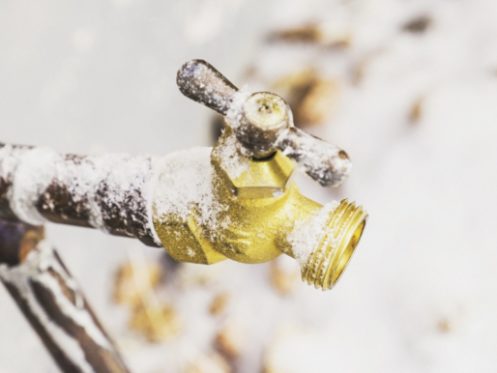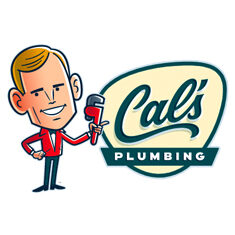With the winter months quickly approaching, it’s important to prepare your plumbing for the colder temperatures. There is a lot to do to best prepare your plumbing to survive the winter, and not preparing for the cold temperatures could result in frozen pipes and other plumbing issues. This handy guide will walk you through all the steps you’ll need to take to properly winterize your plumbing for the cold weather.
Winterizing Your Plumbing
If you have any outdoor plumbing like a sprinkler system or pipes that need to be winterized, for instance plumbing in a summer home you don’t use during the winter, it is important to winterize your pipes in preparation for the cold weather. The first step to winterizing your pipes is to turn off the main water valve, then turn off the water pump and water heater. This will protect the heating element in your water heating system when there is no water running through it.
Next, you’ll want to open all the drains, valves, taps, and faucets. This will ensure no water gets trapped and ends up freezing over the winter. All of your faucets should stay open for the entire winter season. After all the faucets are open, you should use an air compressor to blow out the system and clear out any lingering water from the pipes. After that’s done, empty out any water left in the heating tank. Not all heating tanks have floor drains so it might be necessary to attach a garden hose to feed it out to an area where you can let the water drain out. Once the hot water tank is empty, it’s time to empty the holding tank. You can also add antifreeze to help protect the pump over the winter.
Once that’s finished, flush all of the toilets to clear the water out of the toilet plumbing system. Lastly, add a little antifreeze to your toilet, tub, and sink drains to prevent any lingering water from freezing in the cold temperatures.
Preventing Freezing Pipes
Just because you’re using your plumbing regularly doesn’t mean you’re completely safe from freezing pipes. Pipes that run through basements, attics, garages, or any other uninsulated area are at increased risk for freezing. There are a few steps you can take to help make sure these at-risk pipes don’t freeze.
Insulating any pipes you can access is an easy and cost-effective way of protecting your pipes from cold weather. Pipe insulation is extremely affordable and super easy to apply. Simply wrap the insulation around the pipe, add a little tape around the insulation to secure it, and you’re done. This added protection will help keep your pipes nice and warm over the winter and can stay on during the warmer months without any risk to your water system.
Keep your heating system well-maintained in the home. A lot of the piping that runs through the walls of your home relies on your home heating system to keep them warm. If the overall temperature of your house drops down to freezing temperatures, your entire plumbing system might end up at risk for freezing.
Make sure there are no cracks in the foundation or exterior walls of your home. Cracks can lead to cold air getting into your home and making its way past insulation that’s supposed to help keep the cold air from reaching your pipes. If you do find any cracks or damage, try to get it repaired as soon as possible either through a repair service or through the use of simple caulking.
Make sure the water is continually flowing through your pipes. Simply letting your faucets drip or trickle water can help keep your pipes from freezing. Stagnant water freezes faster than running water, so keeping the water in your plumbing moving, even if just a little, will help keep the water from freezing as quickly in colder temperatures.
Insulate storage areas like attics or garages. If you can’t access the pipes running through your storage spaces, insulating the entire area can help prevent the pipes from freezing. By insulating the entire space, you’ll also be insulating the pipes and helping prevent the cold air from reaching them.
Checking For Frozen Pipes
It’s important to not only prepare for the cold weather but to keep up with routine maintenance to make sure you don’t have any pipes that are frozen. There are a few key things that might clue you into a potentially freezing pipe, either by looking at how the plumbing in your house is working or physically looking at the exposed pipes themselves.
If you see a drop in water pressure to a specific set of faucets or just a single faucet, it might be a sign you have a frozen pipe somewhere leading to the faucet. If multiple faucets are showing reduced pressure, the freeze might be farther back in the plumbing line before the main pipe starts branching off. If the pressure in your entire home is low, it’s likely there’s some other issue causing the pressure to drop.
If you can visually see the pipes, look for any areas that are bulging or swollen. As the ice expands and water builds up behind it, it will put pressure on the walls of the pipe and cause it to bulge out. This could possibly lead to a ruptured pipe and should be dealt with quickly. If you see a bulging pipe, turn off the main valve and open the faucet the pipe leads to. This will both cut off the supply of water to keep the pipe from further bulging as well as give the blockage somewhere to flow out of once the frozen section is thawed. From there, warm the affected area using warm towels, a blow dryer, or even putting a heater near it. If you are using an electrical source of heat, do keep in mind there might be some dripping or leakage from the pipe if it’s started to crack, which could pose an electrical hazard. Once the pipe is thawed, turn the water back on and check for leaks. If you find there are cracks or leaks in the pipe, it’s best to call your plumbing professionals to handle replacing the section of the damaged pipe.
Need Help With Winter Maintenance?
If you need help with your winter plumbing maintenance, call the professionals at Cal’s Plumbing. They’ll be able to inspect your system for any leaks or any pipes that might be at risk of freezing and offer solutions to help keep your plumbing system intact and fully functional this winter season. If they do find any damage, they’ll give you a fair and reasonable estimate and get your repairs done as soon as possible. They also offer repiping services, emergency repairs, gas line maintenance, installation, drain cleaning, water heater installation and repair, and water treatment services in Tucson and the surrounding area. If you think you might be having plumbing trouble this winter, or just want to be well-prepared, don’t hesitate to call Cal’s Plumbing to have your system looked at today.






